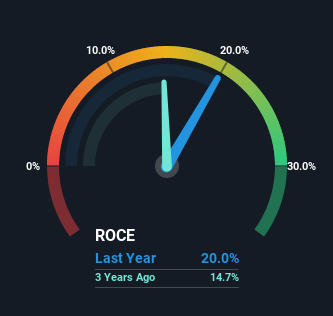If we want to find a potential multi-bagger, often there are underlying trends that can provide clues. Firstly, we'd want to identify a growing return on capital employed (ROCE) and then alongside that, an ever-increasing base of capital employed. Put simply, these types of businesses are compounding machines, meaning they are continually reinvesting their earnings at ever-higher rates of return. So while Tharisa (JSE:THA) has a high ROCE right now, lets see what we can decipher from how returns are changing.
What Is Return On Capital Employed (ROCE)?
For those that aren't sure what ROCE is, it measures the amount of pre-tax profits a company can generate from the capital employed in its business. Analysts use this formula to calculate it for Tharisa:
Return on Capital Employed = Earnings Before Interest and Tax (EBIT) ÷ (Total Assets - Current Liabilities)
0.20 = US$161m ÷ (US$1.0b - US$199m) (Based on the trailing twelve months to March 2022).
Thus, Tharisa has an ROCE of 20%. On its own, that's a very good return and it's on par with the returns earned by companies in a similar industry.
Check out our latest analysis for Tharisa

Above you can see how the current ROCE for Tharisa compares to its prior returns on capital, but there's only so much you can tell from the past. If you'd like, you can check out the forecasts from the analysts covering Tharisa here for free.
What The Trend Of ROCE Can Tell Us
In terms of Tharisa's historical ROCE movements, the trend isn't fantastic. While it's comforting that the ROCE is high, five years ago it was 31%. Although, given both revenue and the amount of assets employed in the business have increased, it could suggest the company is investing in growth, and the extra capital has led to a short-term reduction in ROCE. And if the increased capital generates additional returns, the business, and thus shareholders, will benefit in the long run.
What We Can Learn From Tharisa's ROCE
While returns have fallen for Tharisa in recent times, we're encouraged to see that sales are growing and that the business is reinvesting in its operations. And the stock has followed suit returning a meaningful 82% to shareholders over the last five years. So should these growth trends continue, we'd be optimistic on the stock going forward.
One more thing: We've identified 5 warning signs with Tharisa (at least 2 which make us uncomfortable) , and understanding them would certainly be useful.
If you want to search for more stocks that have been earning high returns, check out this free list of stocks with solid balance sheets that are also earning high returns on equity.
Valuation is complex, but we're here to simplify it.
Discover if Tharisa might be undervalued or overvalued with our detailed analysis, featuring fair value estimates, potential risks, dividends, insider trades, and its financial condition.
Access Free AnalysisHave feedback on this article? Concerned about the content? Get in touch with us directly. Alternatively, email editorial-team (at) simplywallst.com.
This article by Simply Wall St is general in nature. We provide commentary based on historical data and analyst forecasts only using an unbiased methodology and our articles are not intended to be financial advice. It does not constitute a recommendation to buy or sell any stock, and does not take account of your objectives, or your financial situation. We aim to bring you long-term focused analysis driven by fundamental data. Note that our analysis may not factor in the latest price-sensitive company announcements or qualitative material. Simply Wall St has no position in any stocks mentioned.
About JSE:THA
Tharisa
An investment holding company, engages in the mining, processing beneficiation, marketing, sale, and logistics of platinum group metals (PGMs) and chrome concentrates in South Africa, China, Singapore, Hong Kong, the United Arab Emirates, an internationally.
Flawless balance sheet and fair value.
Market Insights
Community Narratives



